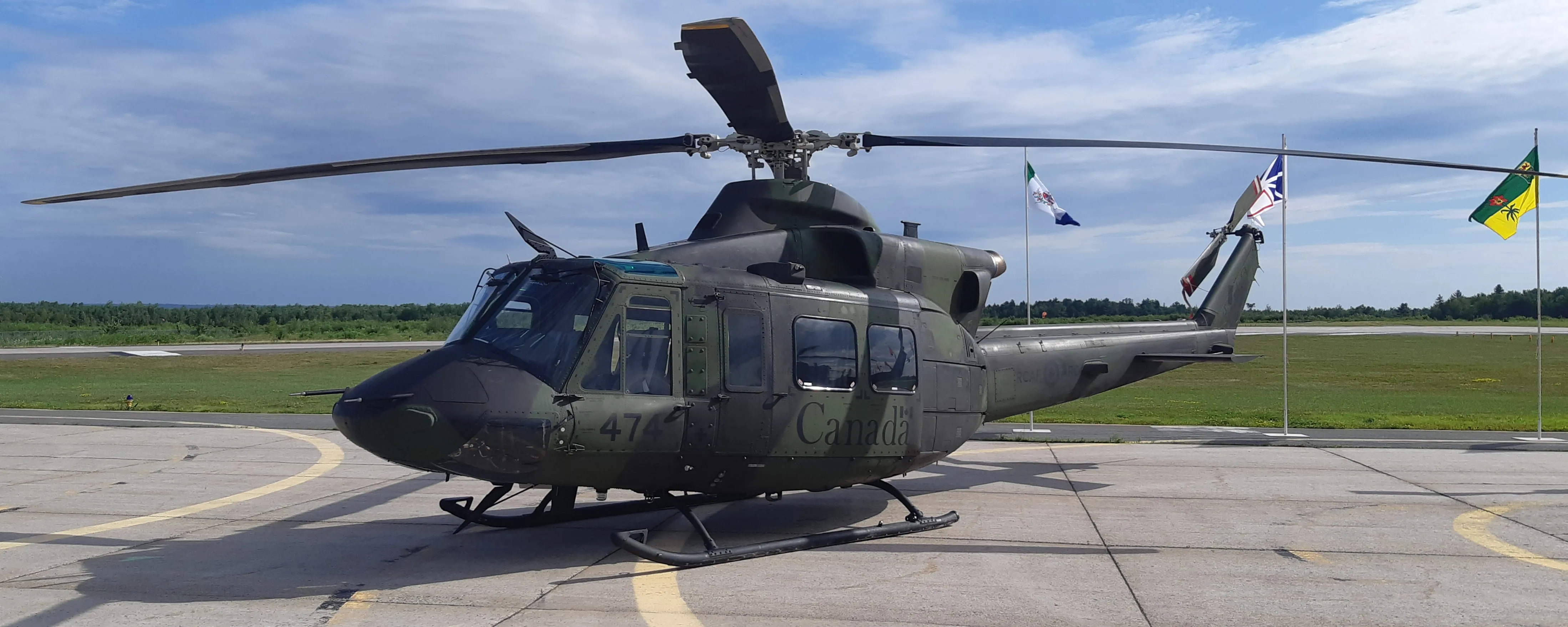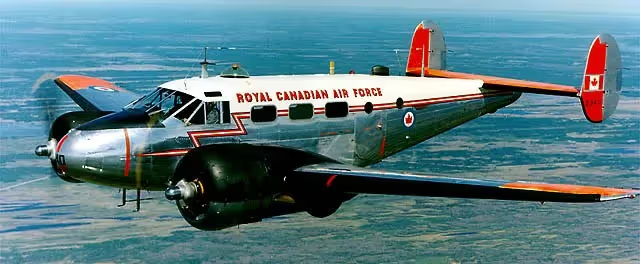Canadian Warplanes (7) New Brunswick, 403 Helicopter Operational Training Squadron
403 Helicopter Operational Training Squadron, 5 CDSB Gagetown

(Author Photo)
Bell CH-146 Griffon helicopter currently in service with 403 Helicopter Operational Training Squadron, 1 Wing, 1 Canadian Air Division. 5 Canadian Division Support Group Base Gagetown, New Brunswick, 24 July 2025.
.webp)
(Author Photo)
LCol Andrew J. Webb and his daughter take the salute at the 403 Helicopter Operational Training Squadron at 5 CDSB Gagetown 24 July 2025. LCol Alan E. Ireland handed over his "Wolf Squadron" in the presence of Colonel D.W. Forbes, Commander 1 Wing. "Stalk and Strike". Nice element of family, and a great handover.

No. 403 Squadron crest.

(Author Photo)
Bell CH-146 Griffon helicopter, No. 403 Helicopter Operational Training Squadron, Pennfield Ridge, New Brunswick, 7 June 2024.
No. 403 "City of Calgary" (Helicopter) Operational Training Squadron (403 Sqn) is a squadron of the RCAF, based at 5 Canadian Division Support Base Gagetown, New Brunswick. It is currently equipped with Bell CH-146 Griffon helicopters and provides operational aircrew training to the crews who will fly the helicopter. The squadron also conducts operational test and evaluation, develops aviation tactics and carries out operations in support of the 1 Wing mission. It also supports the local Army requirements of the Combat Training Centre at 5 CDSB Gagetown. It was founded as No. 403 Squadron RCAF.
A pilot will spend three months at Gagetown learning to fly the Griffon before being posted to one of 1 Wing's five operational squadrons. While at Gagetown, pilots learn advanced aircraft handling, including slinging and hoisting, tactical formation, flying and low-level tactical flying.

The squadron was established as No. 403 (Fighter) Squadron at Royal Air Force Station Baginton, Warwickshire, England, on 1 March 1941. It was the first squadron of RCAF formed overseas under the British Commonwealth Air Training Plan (BCATP), and it was identified by the letters KH.


(RCAF Photos)
Curtiss P-40 Tomahawks of No. 403 Squadron, RCAF Based at Baginton in the UK in 1941. (Note the KH code).
Initially equipped with the Curtiss P-40 Tomahawk Mk. I fighters, these were shortly replaced with Supermarine Spitfires after just 29 operational sorties. Through continuous replacement and updating, the squadron flew various model Spitfires from Mk. I through Mk. XVI. The squadron flew with RAF Fighter Command and the Second Tactical Air Force for more than four years.

(RCAF Photo)
No. 403 Squadron group photo, 12 August 1942. CAF Sergeant Pilot Victor Nicholas Cabas, from New Castle, Pennsylvania is in the back row, first on the left. He became an ace flying Supermarine Spitfires with the USAAF's 52nd Fighter Group. After a 31 year career flying 25 aircraft types, he retired from the USAF in 1971 as a Brigadier General. His overall favourite plane was the Spitfire. Just one of the 8,864 Americans who served in the RCAF in the Second World War. (Tom Walsh)

(RCAF Photo via James Craik)
Supermarine Spitfire Mk. IX, coded KH-A, No. 403 Squadron in the UK, ca 1944.

(DND Photo)
George Frederick "Buzz" Beurling, DSO, DFC, DFM & Bar (6 December 1921 – 20 May 1948), the most successful Canadian fighter pilot of the Second World War. George Beurling scored his 30th aerial victory while flying with 403 Squadron in a Spitfire Mk. IX in 1943.

(wordpress Photo)
Supermarine Spitfire Mk. IX (Serial No. KJ664), coded KH-P, No. 403 Squadron in the UK, ca 1944.
By May 1945, the squadron had a record of 123 enemy aircraft destroyed, with a share in seven more, 10 probably destroyed, and 72 damaged with a share in one more. Ground targets destroyed or damaged included 30 tanks, 50 locomotives, and nearly 100 other vehicles. Sixteen Distinguished Flying Crosses (DFC), four DFCs with Bar, and one Military Medal were awarded to members of the Squadron, in addition to a number of Mentions in Despatches. The "Wolf" Squadron and many other units paid a high price in lives and aircraft. Eighty-five aircraft were destroyed. 76 pilots were reported missing; of these, four were killed, 39 presumed dead, 21 captured, and nine successfully evaded capture.
The squadron wa awarded seven battle honours for its wartime service:
Defence of Britain 1941-1944.
English Channel and North Sea 1942.
Fortress Europe 1941-1944.
Dieppe 1942.
Normandy 1944.
Rhine 1944.
France and Germany 1944-1945.
Post war
Early in 1948, ex-Air Force officers in Calgary pressed for the formation of an Auxiliary Squadron in the city. An active campaign was undertaken and, in June 1948, the reformation, effective 15 October 1948, of No. 403 Auxiliary Squadron with a Fighter-Bomber designation was announced. Its primary role would be close support to the Army.

(DND Photo)
North American P-51D Mustang, RCAF, 403 Sqn, Calgary, Alberta, ca 1950s.
Early pilots were highly experienced veterans with operational experience on a variety of aircraft. The reformed squadron was equipped with the North American Harvard Mk. II, and received the first of its North American P-51D Mustangs in the latter part of 1950. It would remain in service until 1958 when the type was retired from RCAF service. F/O Lynn Garrison was the last 403 pilot to fly the Mustang.

(DND Photo via James Craik)
North American P-51D Mustang, RCAF (Serial No. 9279), No. 403 Sqn.

(DND Photo via James Craik)
North American P-51D Mustang, RCAF (Serial No. 9281), No. 403 Squadron, City of Calgary.
In January 1952, the squadron enlisted its first female officer, P/O V.A. Harding. In September 1952, "City of Calgary" was incorporated into the squadron's title. In November 1953, the squadron's title was changed to "Fighter" Squadron.

(DND Photo via James Craik)
Canadair CT-133 Silver Star Mk. 3 (Serial No. 21627).
In October 1955 the squadron received its first jet, the Canadair CT-133 Silver Star.

(RCAF Photo)
Beechcraft 18B Expeditor Mk. 3NM (Serial No. 2340) in flight.
In June 1956, the squadron was informed that its role was to change and that it would be re-equipped with the Beechcraft C-45 Expeditor and the de Havilland DHC-3 Otter. In addition, it was moved to Air Transport Command, and received its first Navigator.

( DND Photo PCN 70-493)
de Havilland CSR-123 Otter, RCAF (Serial No. 9403), Mobile Command.
The squadron transferred to Training Command in December 1956, with the role of training a reserve of transport aircrew for the Auxiliary and Regular Forces. In February 1958, the squadron became a general Transport and Rescue Squadron responsible for operations in support of military and civilian requirements. During the summer of 1961, the squadron was advised that consideration was being given to equipping the Auxiliary units with helicopters. Nothing came of it but, for the squadron, it was a sign of things to come.

(Mike Kaehler Photo)
Bell CH-118 Iroquois (Serial No. 103), 1969.
In January 1968, the squadron was activated as No. 403 (Helicopter) Operational Training Squadron (Hel) OTS at CFB Petawawa, Ontario, and was equipped with 10 CUH-1 helicopters (CF designation for the UH-1H utility transport helicopter), later designated Bell CH-118 Iroquois helicopters. Once again, it was formed specifically to support the Land Forces.

(Alain Rioux Photo)
Bell CH-135 Twin Huey Helicopter (Serial No. 136137).
In July 1972, the squadron was given the role of training of aircrew and technical personnel for the Tactical Helicopter and Rescue Squadrons. To carry out its new role, the squadron joined No. 422 Squadron at CFB Gagetown, New Brunswick, and was equipped with 11 Bell CH-135 Twin Huey and 10 Bell CH-136 Kiowa helicopters. In August 1980, the squadron gained aircrew and support personnel from the disbandment of No. 422 Squadron.

(Author Photos)
Bell CH-136 Kiowa helicopter, painted in 75th anniversary colours, mounted on a pylon at 5 CDSB Gagetown, New Brunswick.
In August 1980, the Air Ground Operations School was formed to provide advance training for future Flight Commanders and Operations Officers. Renamed the Aviation Tactics Flight in June 1995, the Flight continues to provide this training, and aviation support to the Combat Training Centre, 1 Wing and the Air Force.

MFO flight crest.
As a Rotary Wing Aviation Unit, the squadron conducted two rotations of the Multinational Force and Observers (MFO. The MFO is an international peacekeeping force overseeing the terms of the peace treaty between Egypt and Israel. The MFO generally operates in and around the Sinai peninsula.
In July 1990, the squadron renewed its post-war relationship with the Air Reserves. At that time the Combat Training Centre (CTC) Gagetown Detachment of the CFB Chatham Air Reserve Augmentation Flight (ARAF) took up residence in the squadron. The flight became an integral part of the Squadron in 1996. Renamed the Air Reserve Section in 1998, the squadron's reservists are incorporated into and provide support to all flights.
In August 1992 the Land Aviation Test and Evaluation Flight (LATEF) was formed to conduct, on behalf of 10 Tactical Air Group (10 TAG), operational and tactical testing of land aviation helicopter systems and support equipment, and to propose operational and tactical doctrine where applicable. It quickly evolved into a valuable asset and has been integrally involved in the testing and improvement of CH-146 Griffon systems.
The Kiowa and Twin Huey helicopters were phased out of the squadron by the end of 1994 and early 1995 respectively and were replaced by the Bell CH-146 Griffon in March 1995. The squadron became the first operational CH-146 unit in 10 TAG in October 1995.
In October 1996, a full motion flight simulator was added to the squadron's establishment.
In 2018 and 2019, members of 403 Squadron were dispatched to take part in the United Nations Multidimensional Integrated Stabilization Mission in Mali (MINUSMA), established by Security Council resolution 2100 of 25 April 2013 to support political processes in that country and carry out a number of security-related tasks. The Mission was asked to support the transitional authorities of Mali in the stabilization of the country and implementation of the transitional roadmap.

The Honorary Colonel of 403 Squadron is Johanne Gallant, CEO of Fredericton airport, who succeeded Professor Marc Milner of Fredericton, New Brunswick.

(MSGT Robert A Whitehead, USAF Photo)

No. 403 Squadron shoulder patch.
403 Squadron crew for the Eclipse flypast over the City of Fredericton on 8 April 2024. (403 Sqn Photos)


.avif)
On the way up at 3:45 pm.
.jpeg)
On the way back at 3:52 pm.

(Author Photo)
Bell CH-146 Griffon helicopter, No. 403 Helicopter Operational Training Squadron.
Give this a listen:
https://www.facebook.com/watch?v=859508289178737





